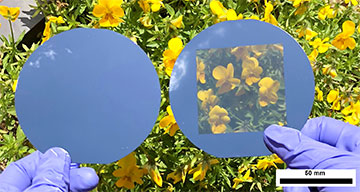
An opaque solar cell (left) compared to a neutral-colored transparent solar cell (right). [Image: Ulsan National Institute of Science and Technology (UNIST)]
Transparent solar cells could bring a new element of artistry to architecture, handheld devices and electric vehicles, if only they could generate energy efficiently without adding tints to the light passing through them. By putting microscale holes through a crystalline silicon wafer, researchers at two Korean universities have created solar cells with these properties (Joule, doi: 10.1016/j.joule.2019.11.008).
From opaque to transparent
Making crystalline silicon solar cells transparent has been a huge challenge for the photovoltaic industry, simply because conventional wafers of this material block the transmission of most visible wavelengths. Thinning the wafers from their usual 150-μm to 200-μm thickness also doesn’t work well because the crystalline silicon still appears red from its inability to pass shorter wavelengths.
The Korean team, led by Kwanyong Seo of the Ulsan National Institute of Science and Technology and Seungwoo Lee of Korea University, got around the transmission problem by creating a 200-μm-thick wafer containing a matrix of round holes between 90 and 100 μm in diameter. The scientists punched the holes in the crystalline silicon via a process called deep reactive ion etching.
Numerical simulations of incident radiation and its reflection, transmission and diffraction through holes of varying widths guided the sizing of the tiny holes. To determine the grid spacing, the team considered the human eye’s minimum angle of resolution—about 1 arcminute, or 0.0167 degrees—and spaced the holes far enough apart that a person wouldn’t see them at a typical smartphone-holding distance of about 30 cm. The filling fraction of the holes determines the transparency of the final wafer, from 20% to 50%, and the transmission of light through the holes is high enough to avoid visual distortion of objects behind the wafer.
Testing photovoltaic performance
Once the holey crystalline silicon wafer was developed, the researchers incorporated it into a photovoltaic cell along with a doped-silicon backplane and a grid-type upper metal electrode. The team measured the cell’s maximum power conversion efficiency at 12.2%.
The scientists expect that the transparent solar cells will be as easy to fabricate as non-transparent cells made from crystalline silicon.
